Abstract
Cocksfoot and Timothy pollen extracts are each found to contain at least fifteen components antigenic in rabbits. Most of these can also be allergens for man, but only a few are regularly so. These `principal' allergens have now been isolated in highly purified form.
Procedures are given for a simple method of preparing extracts for clinical purposes and for the partial separation, concentration and purification of the allergens by means of differential extractions of the pollens and by means of ultrafiltration, isoelectric precipitation and salt fractionations (at acid and neutral pH) of the extracts. Isoelectric precipitations gave highly pigmented acid complexes, two of which moved as single sharp peaks at pH 7.4 in free electrophoresis, but proved to be hardly active by skin tests. Acid NaCl fractionation of the remainder resulted for Cocksfoot and Timothy in the isolation of a nearly white powder (T21.111121112 = T21B) which was weight for weight 1000–10,000 times as active as the pollen from which it had been derived. The powders have retained their activity for 7 years. By gel diffusion tests, they were found to contain two antigens (one in each preparation) which were immunologically partially related, but the Timothy preparation contained in addition the `innermost' `twin' antigens specific for Timothy that we had discovered previously in the crude extracts by gel diffusion methods. Skin reactions could be elicited in hay-fever subjects by prick tests with concentrations of 10-9–10-8 g./ml., which is equivalent to intradermal injections of 10-11–10-10 mg. and represents a 300-fold purification with respect to the concentrates of crude pollen extracts prepared by ultrafiltration and dialysis.
Fractionation on DEAE-cellulose of one of the highly purified Timothy preparations (T21.11112112 = T21A) and other, crude Timothy and Cocksfoot extracts resulted in considerable and reproducible separation of the various antigens, with no indication of the continuous dissociation into smaller fragments reported in recent publications. The immunologically related antigens of Cocksfoot and Timothy were among a number not retained by the DEAE-cellulose at pH 7.4–8.5. These proved to be skin reactive in all the patients tested. When this fraction was prepared from T21.11112112(= T21A) only one main line (plus a faint subsidiary line) was found in the gel diffusion tests. At pH 6.4 the important dissimilar Cocksfoot and Timothy allergens were eluted; the fraction derived from T21A contained only the special `innermost' twin antigens in roughly a further ten-fold purification over and above that achieved in the acid NaCl fractionation.
Full text
PDF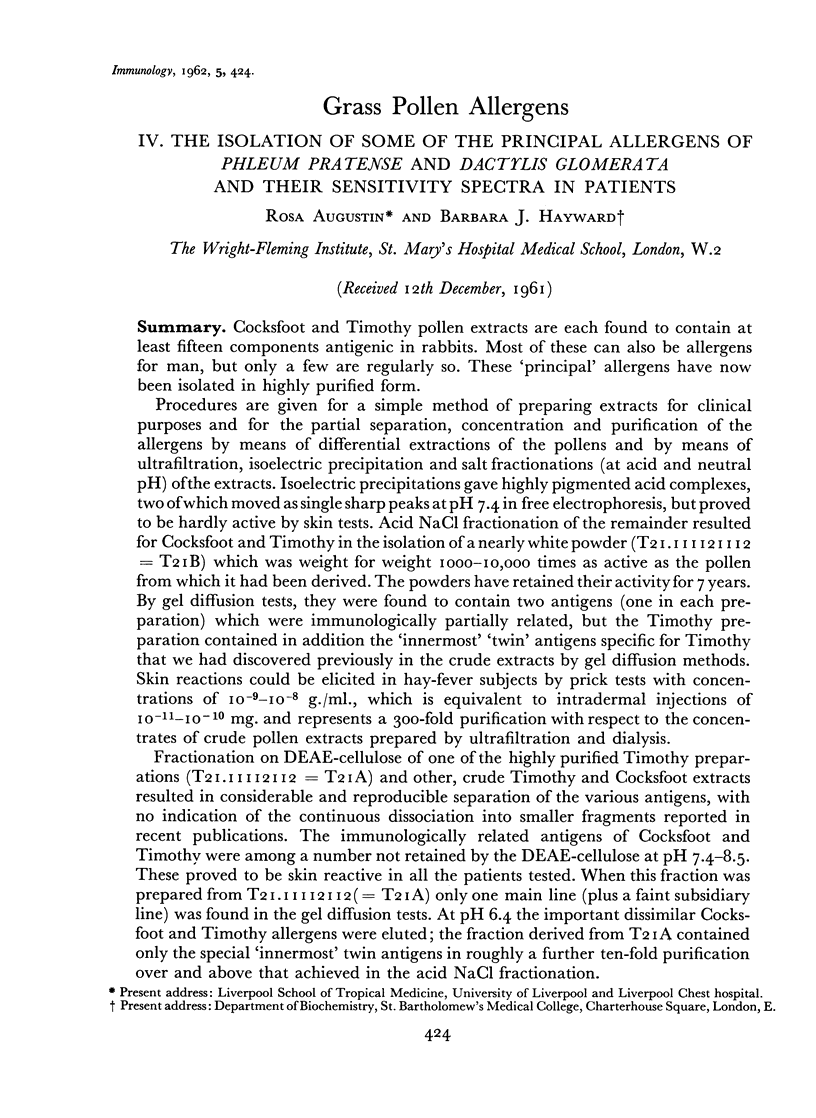


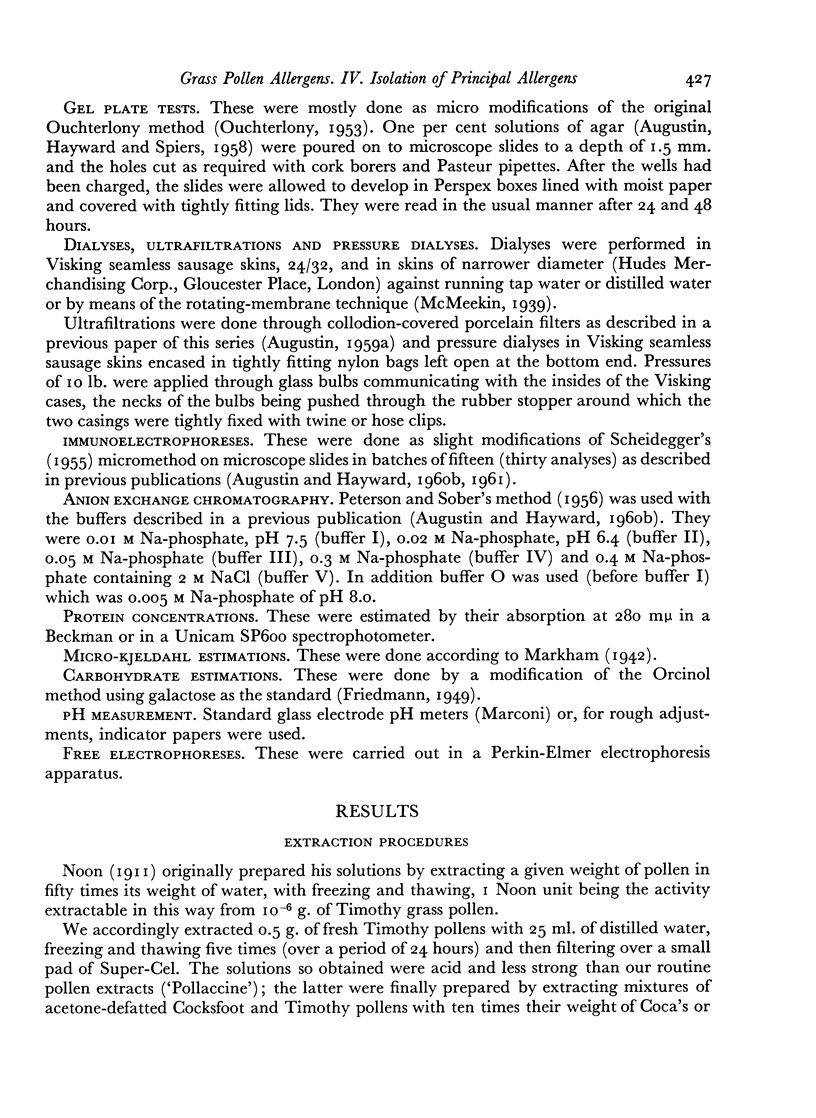
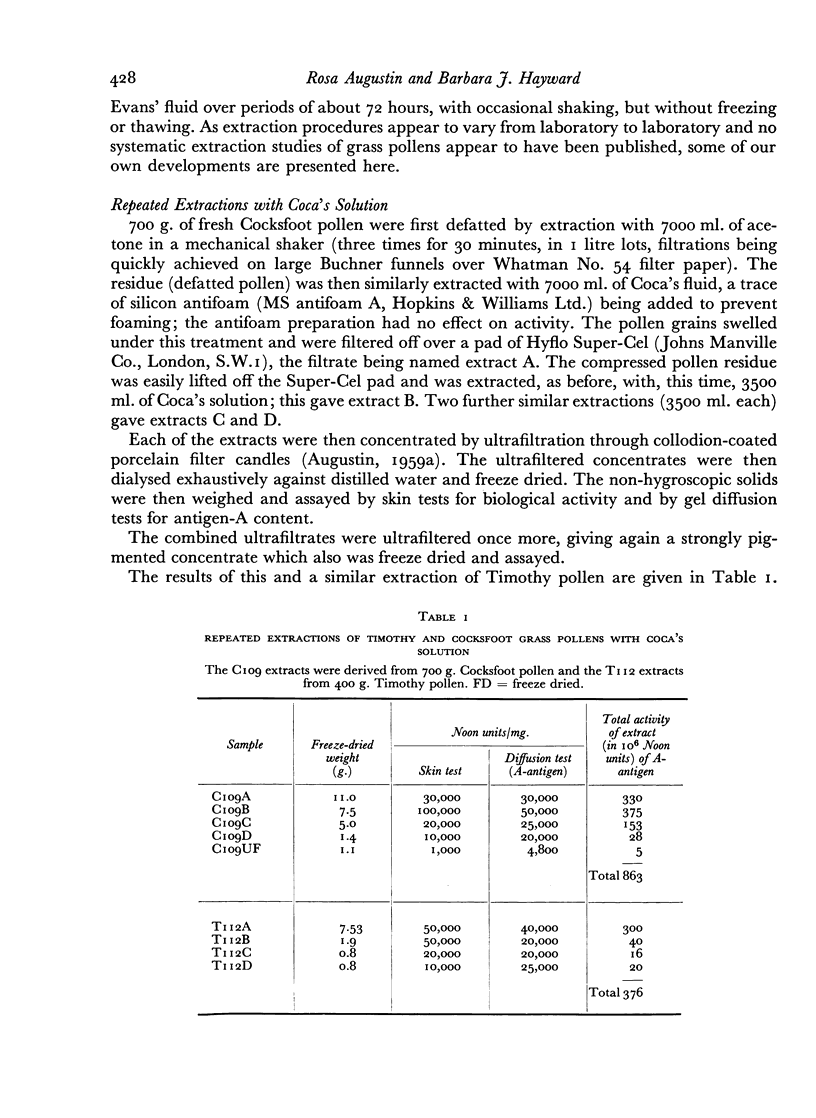
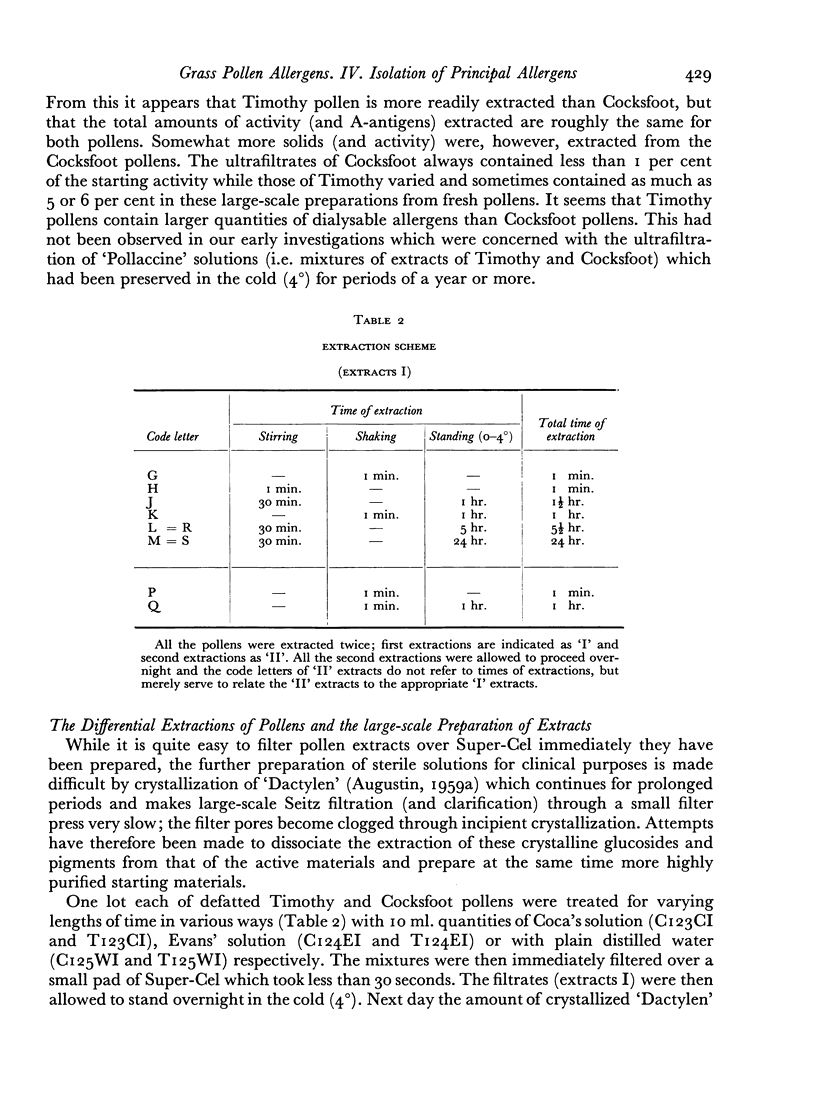
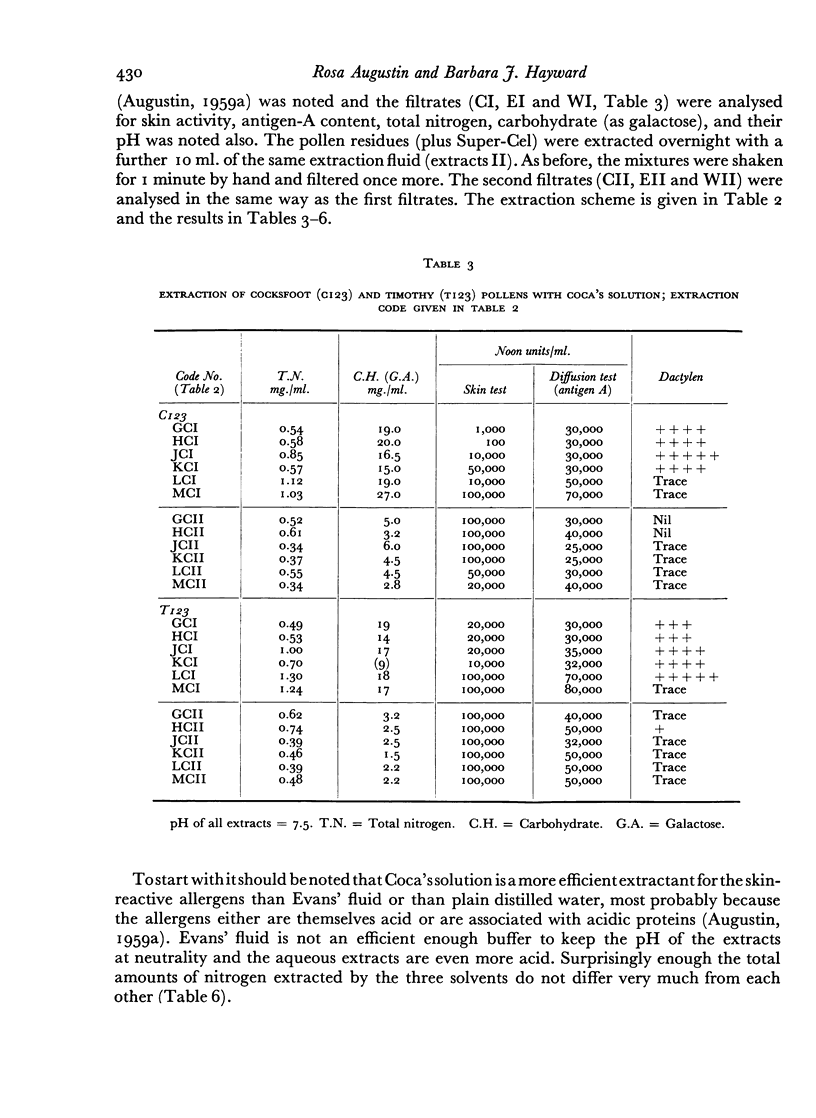



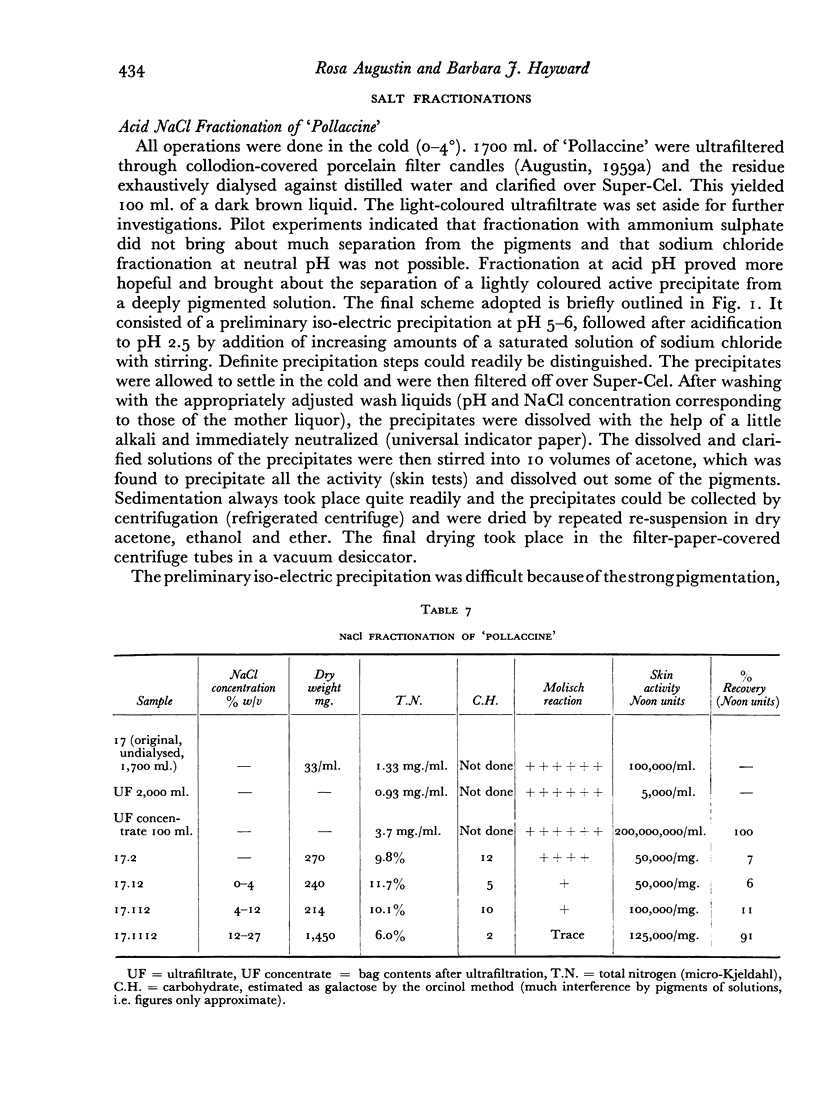
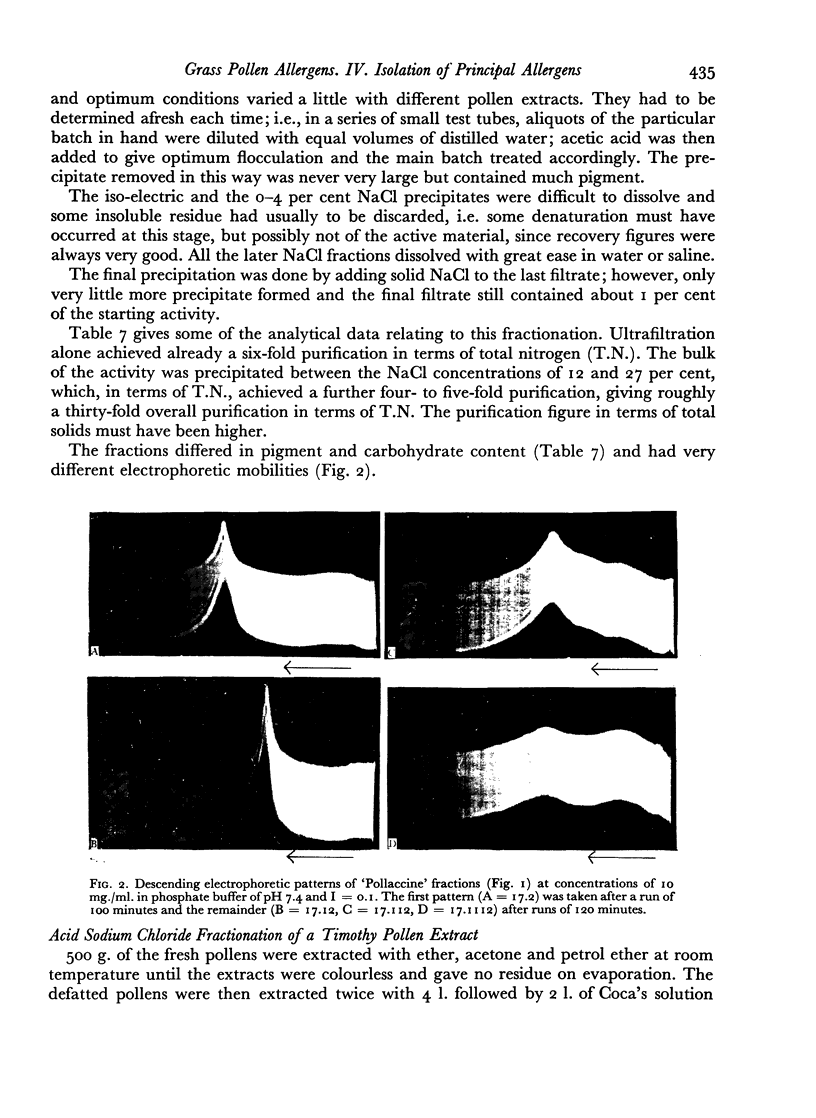

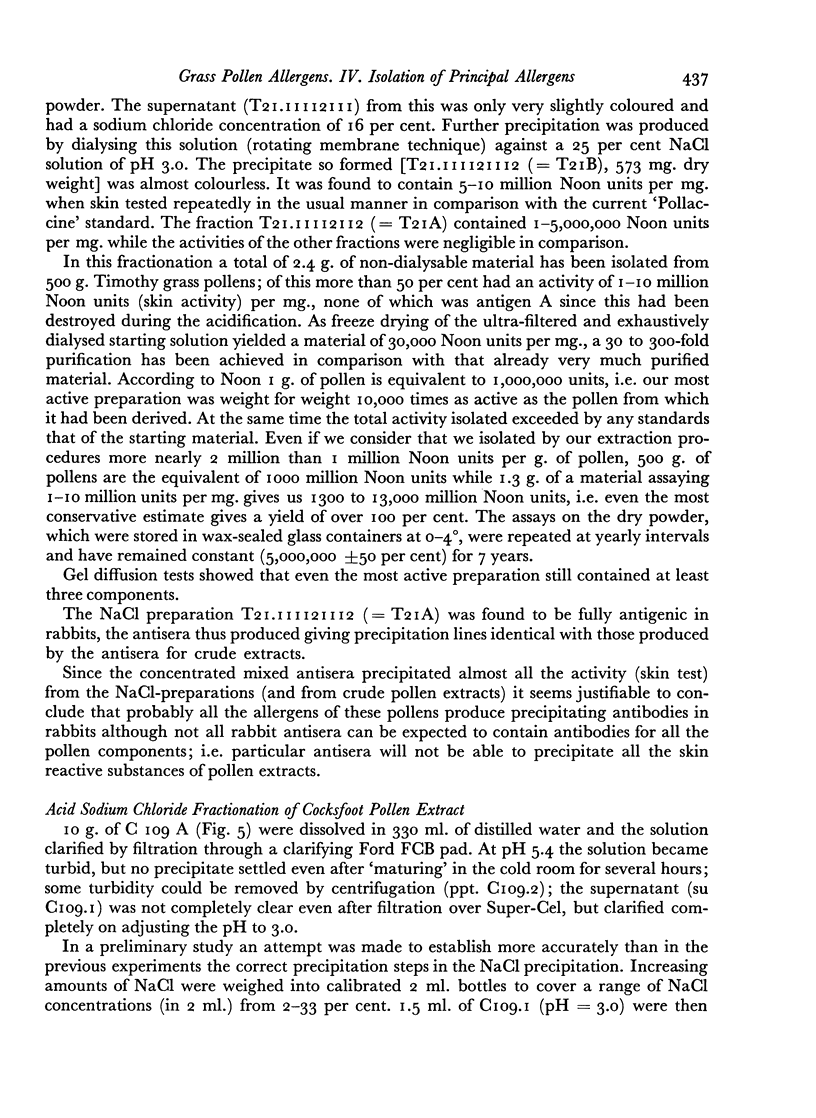


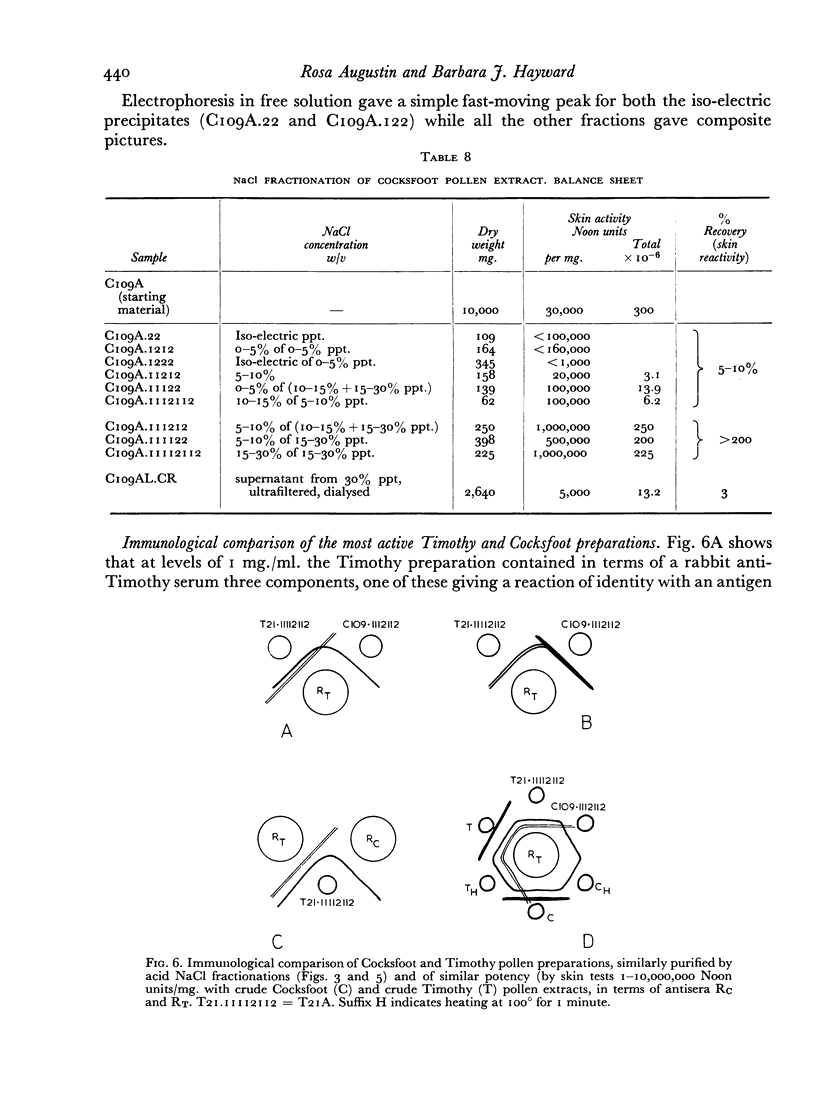

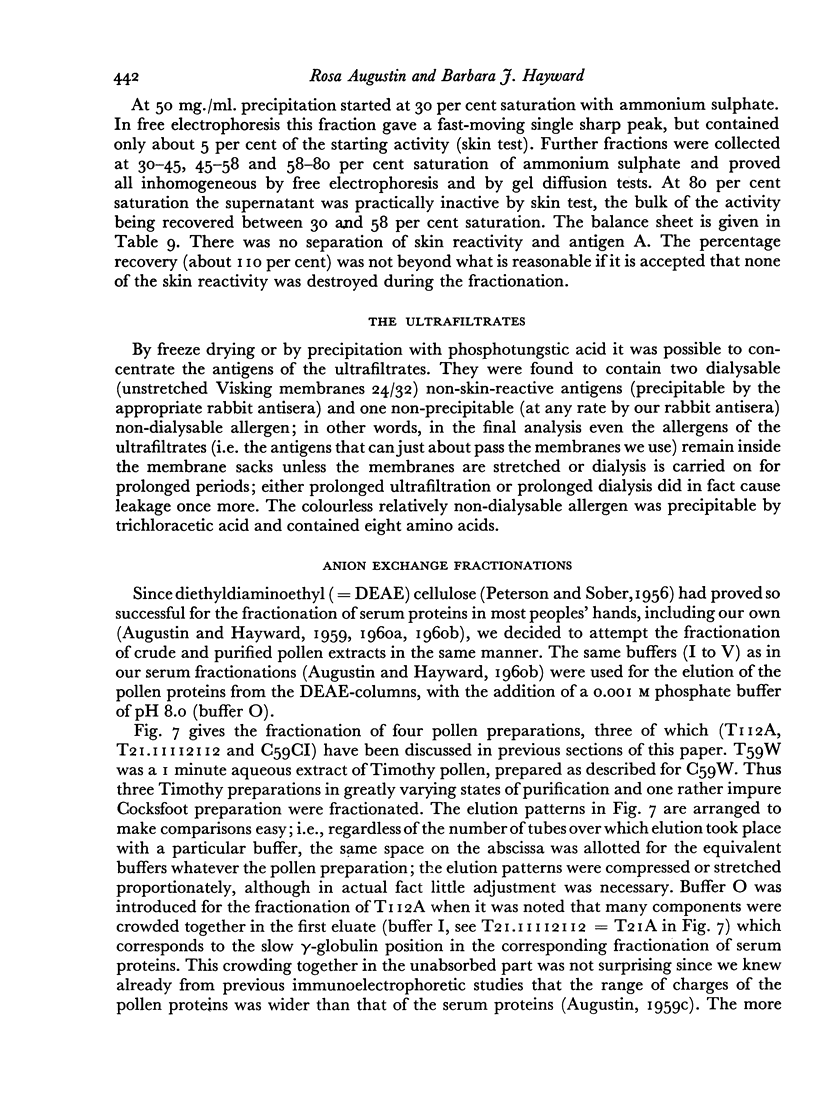

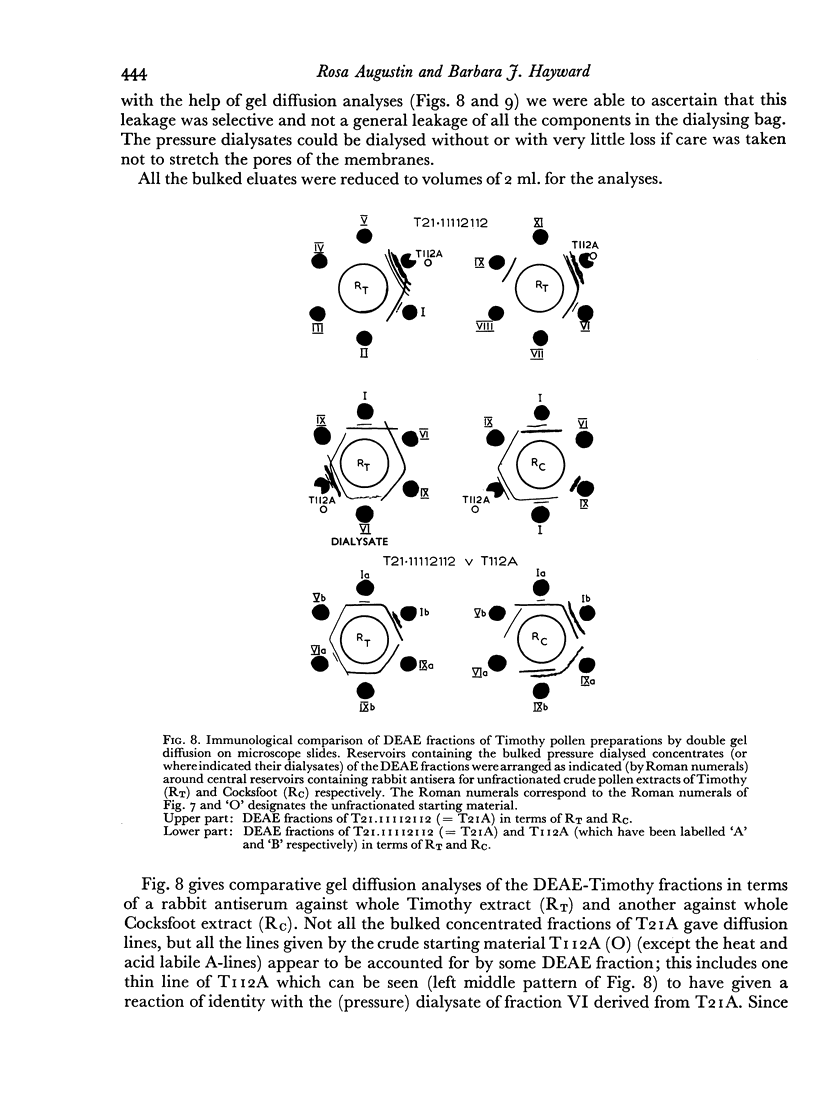

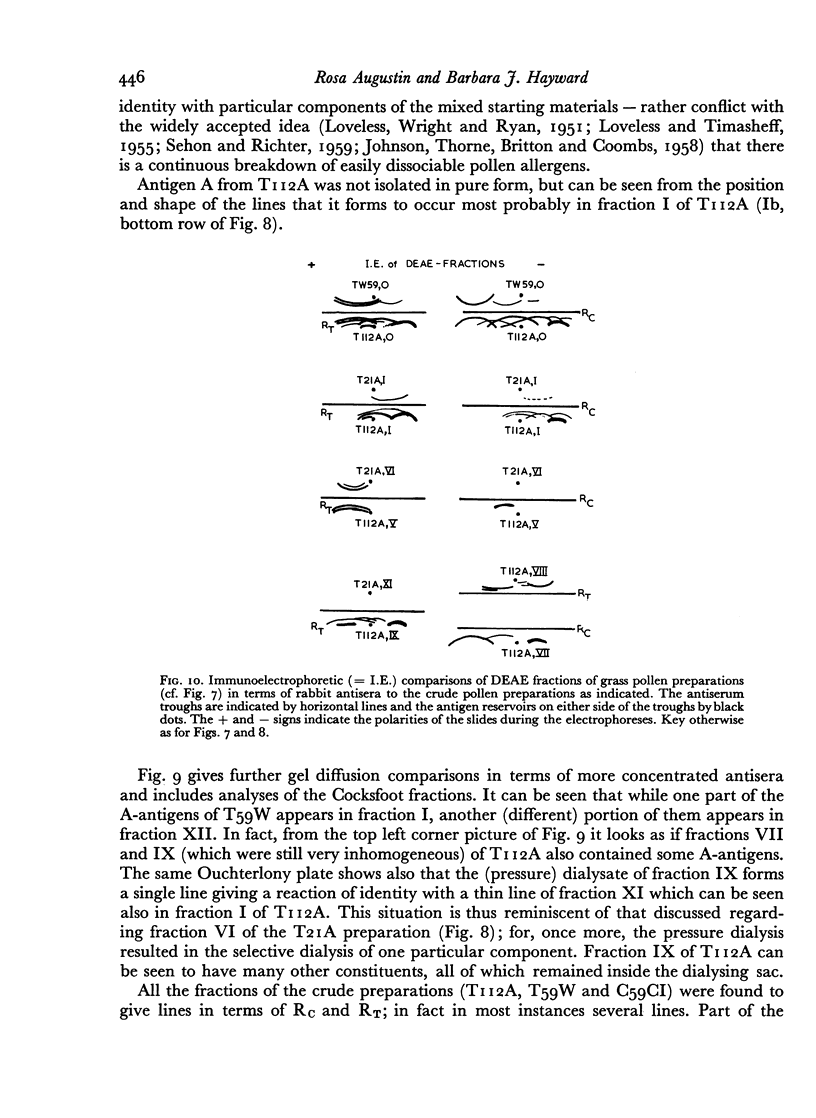
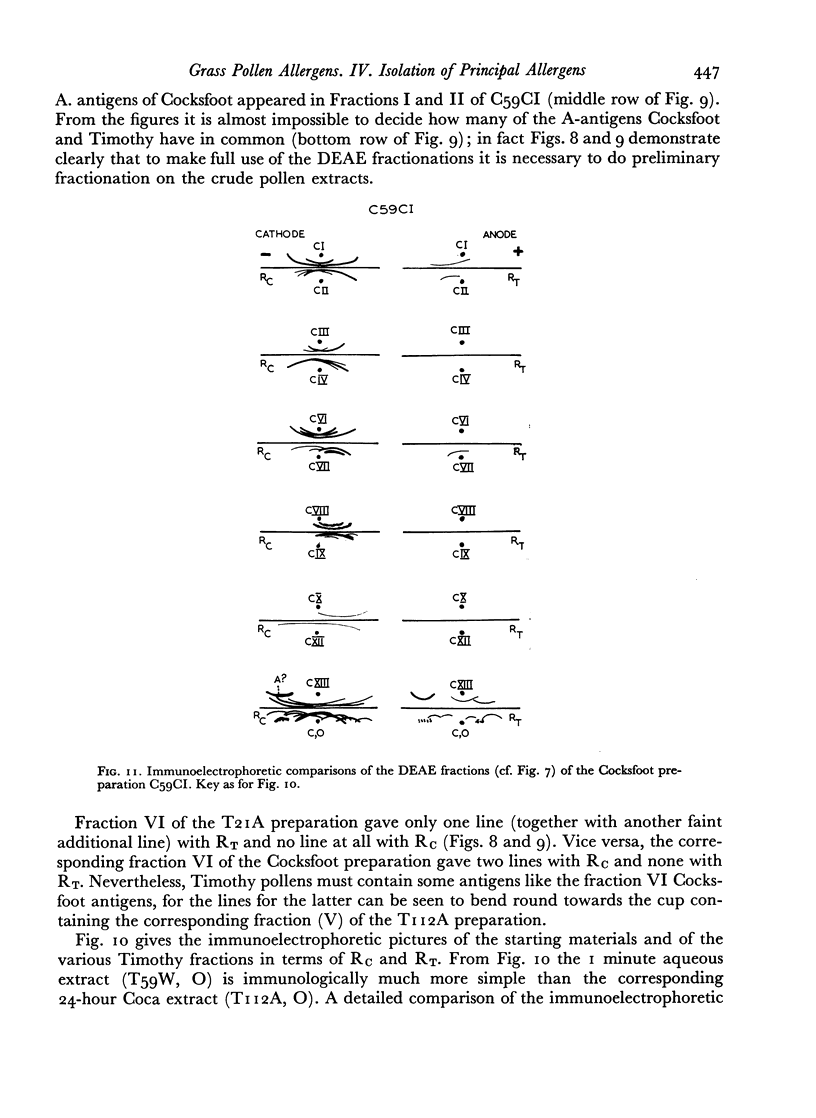
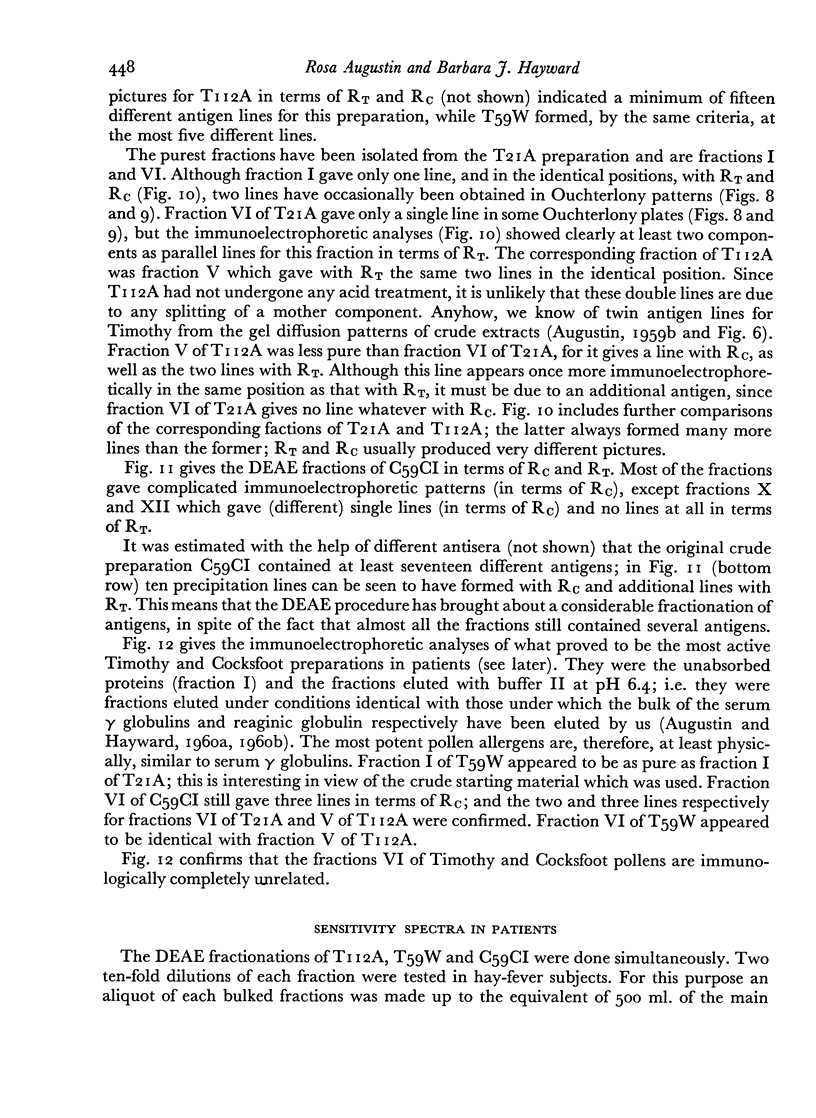
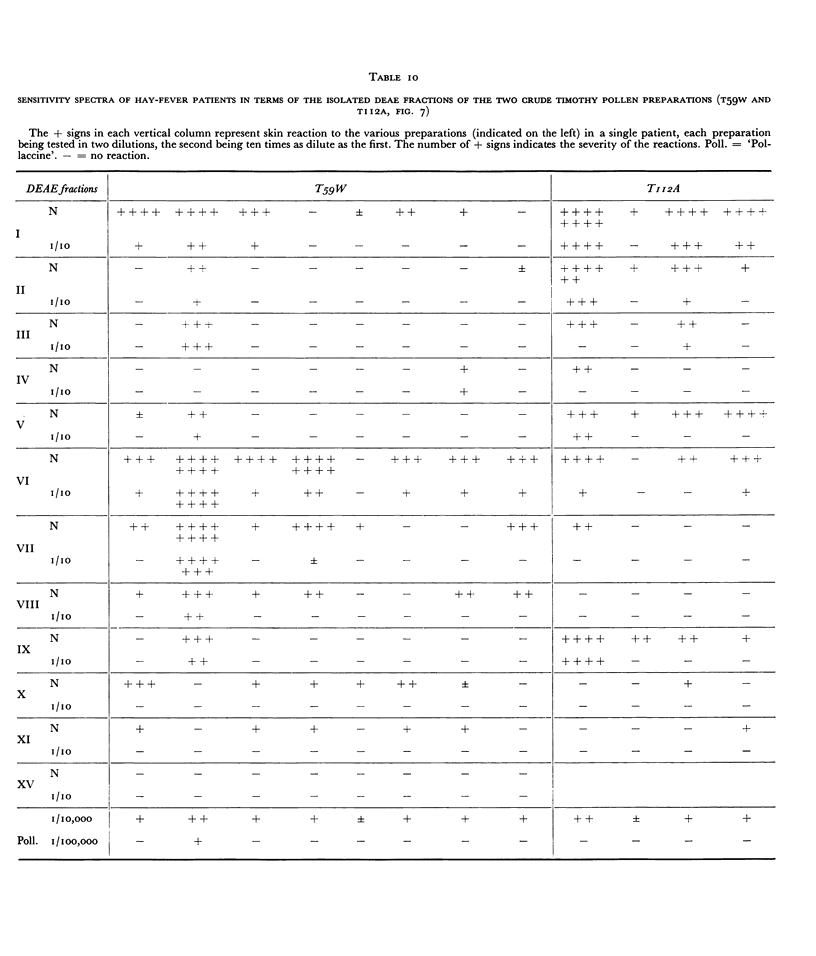
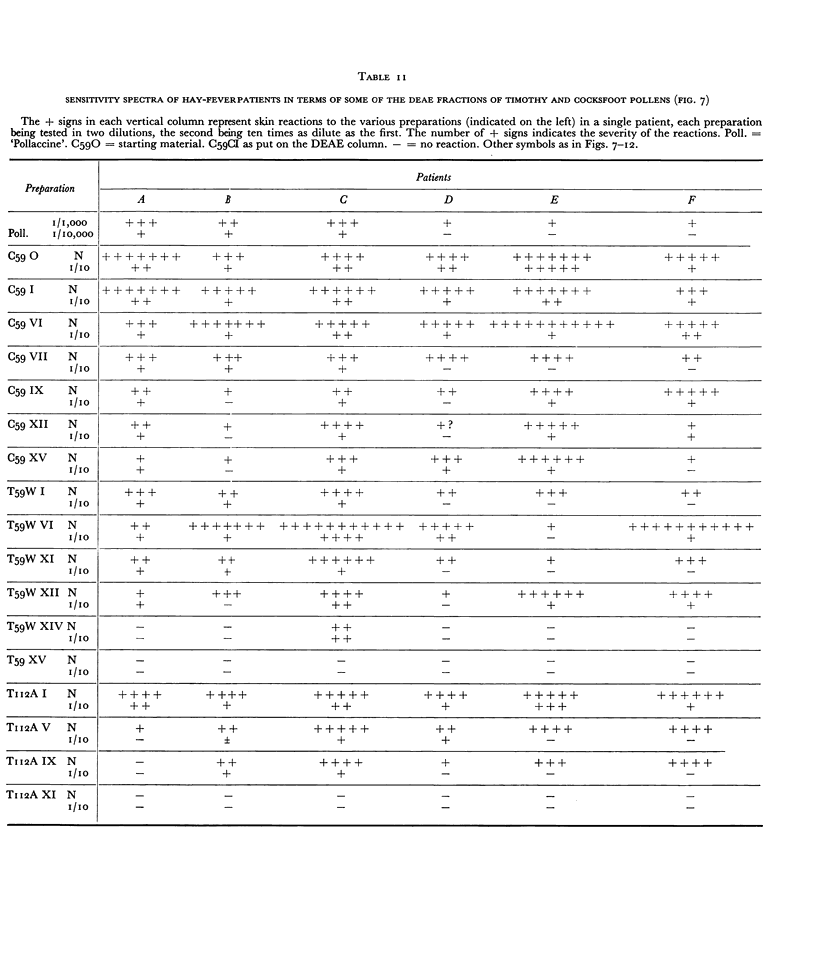
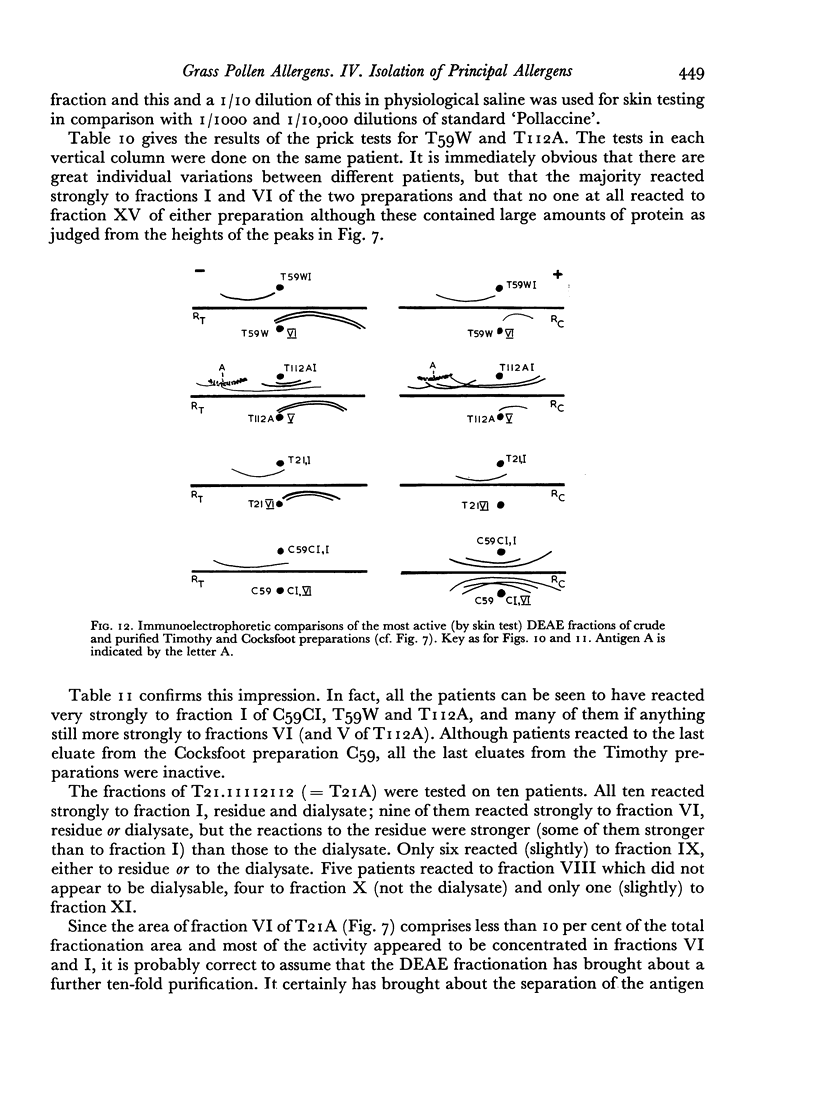
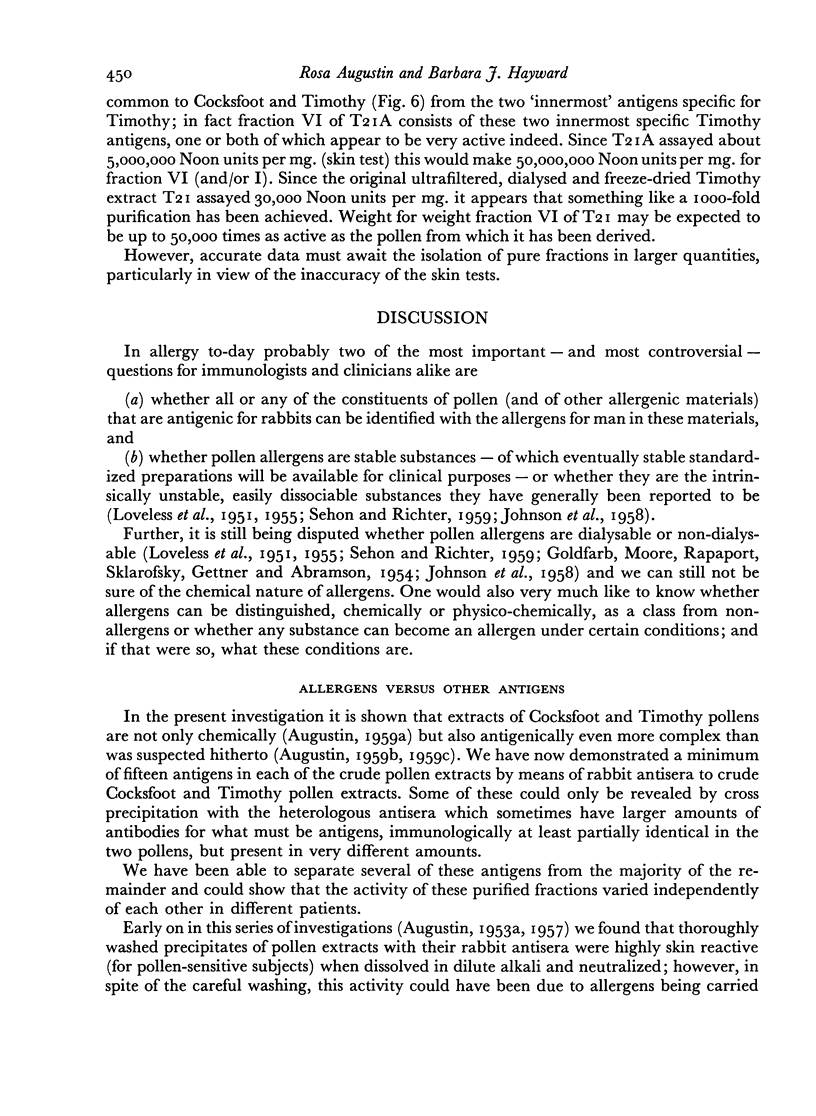
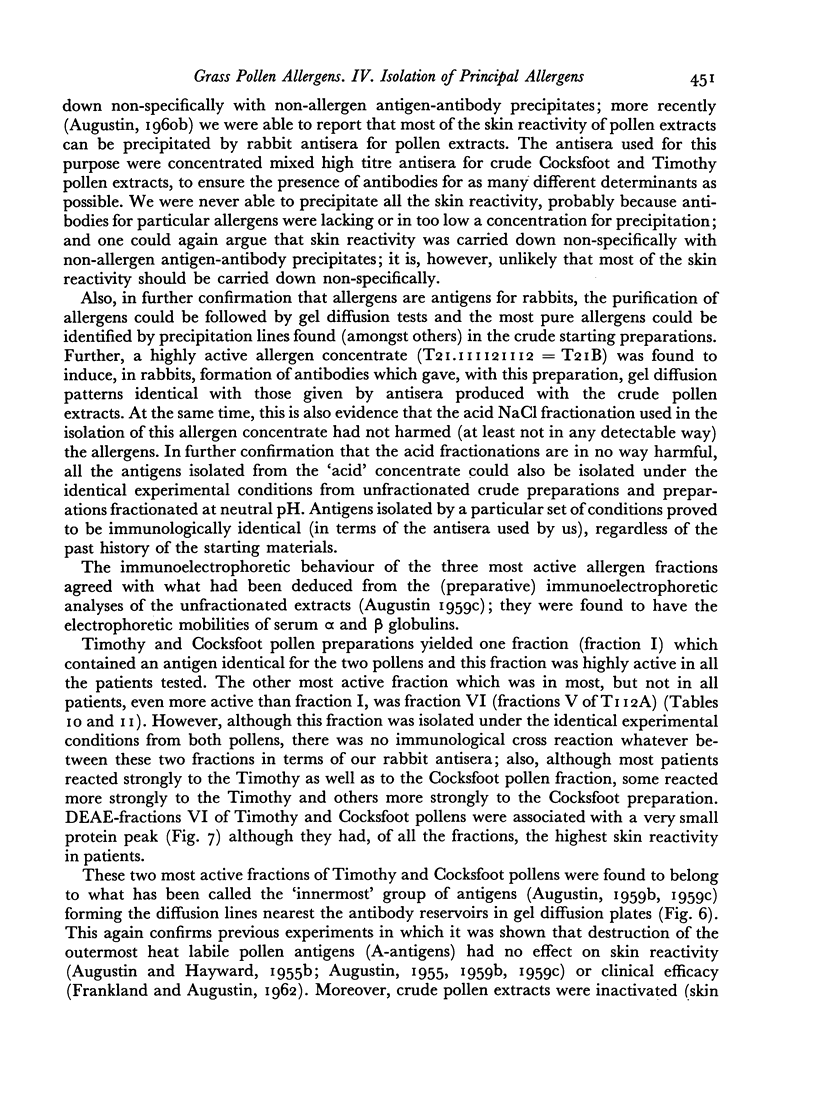
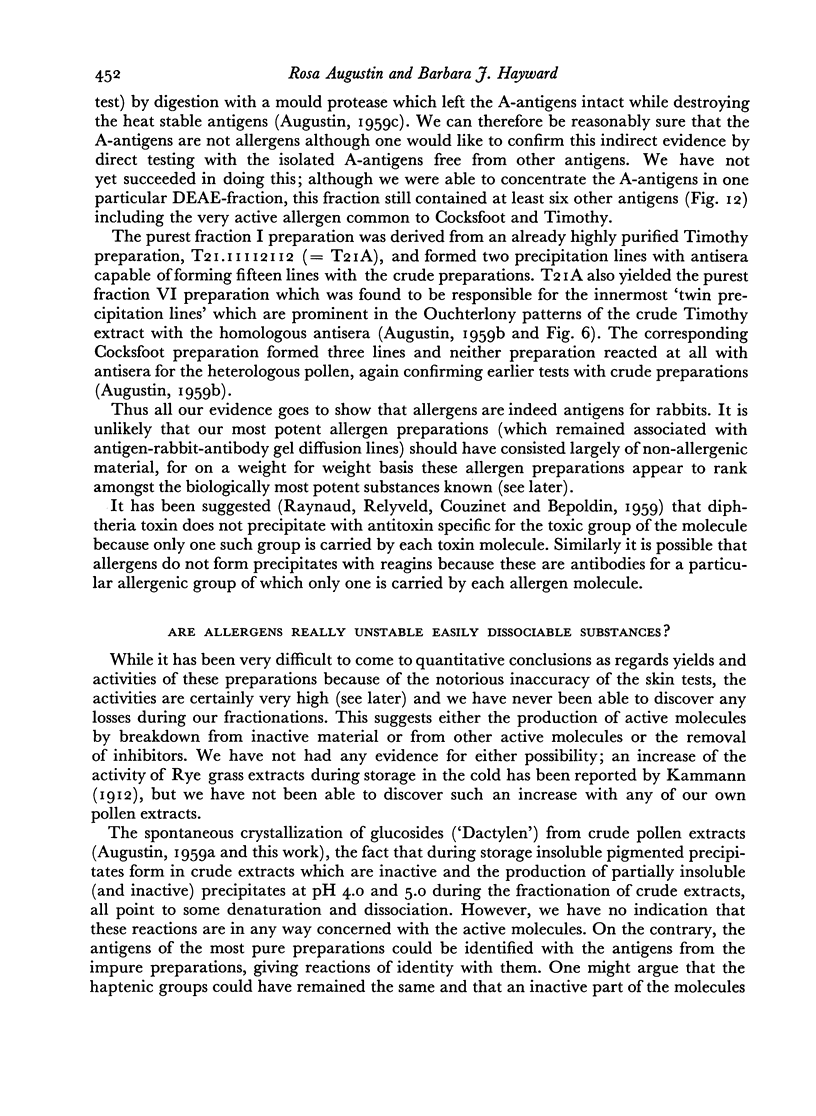
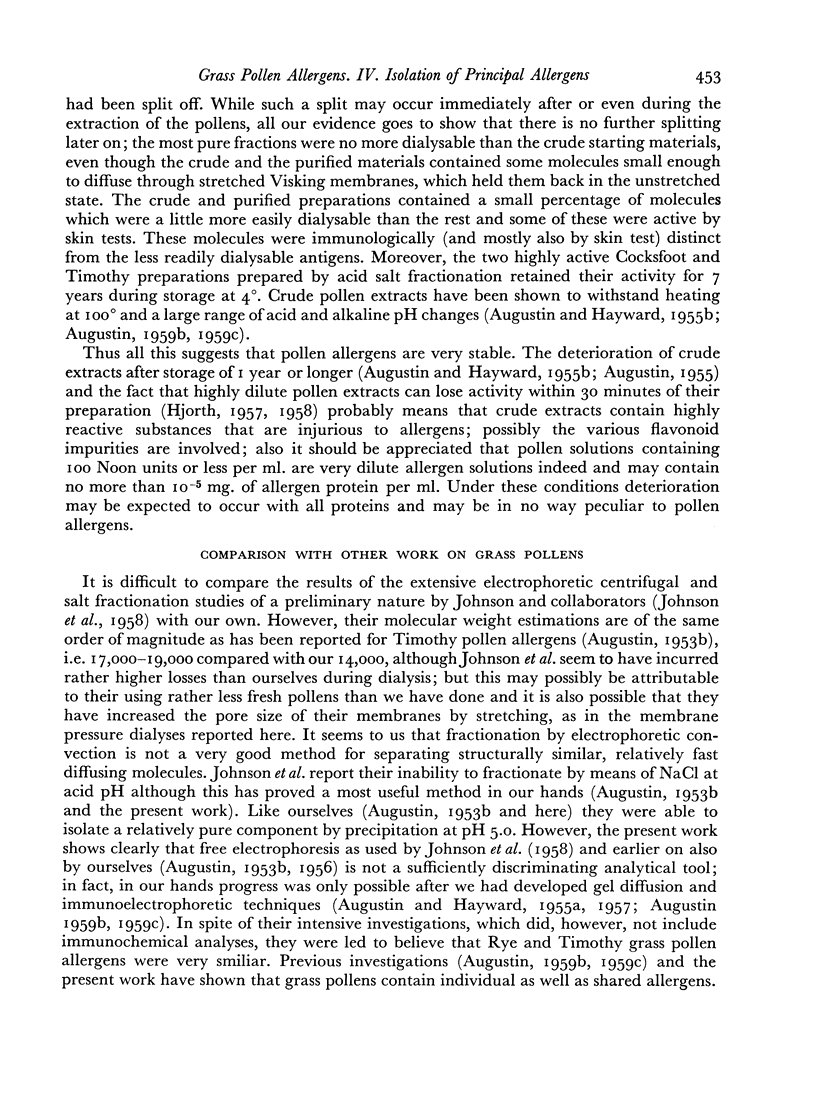
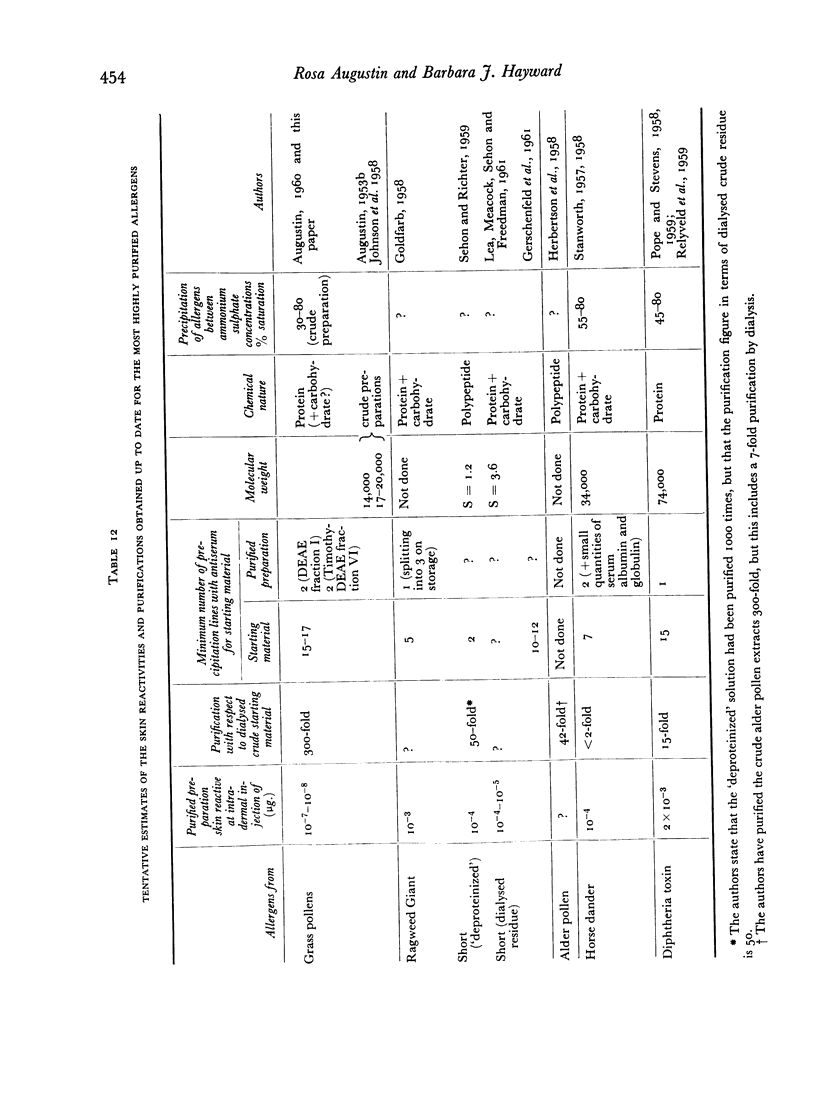
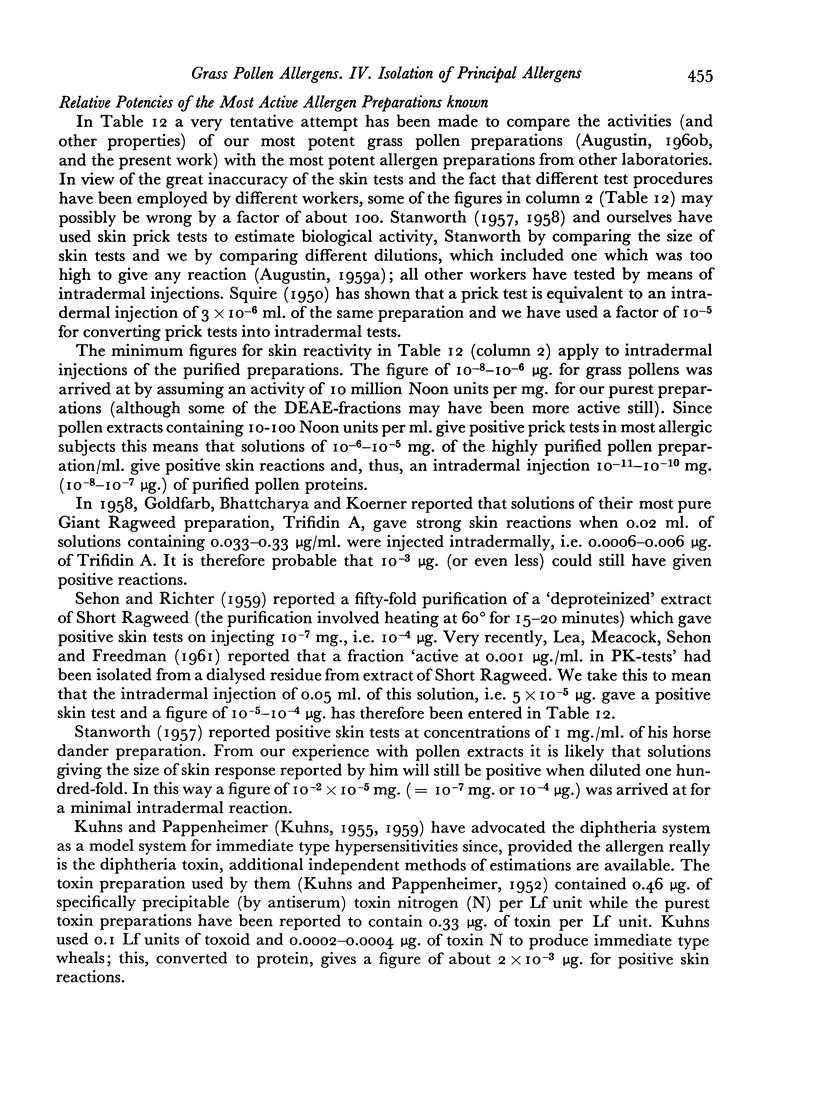


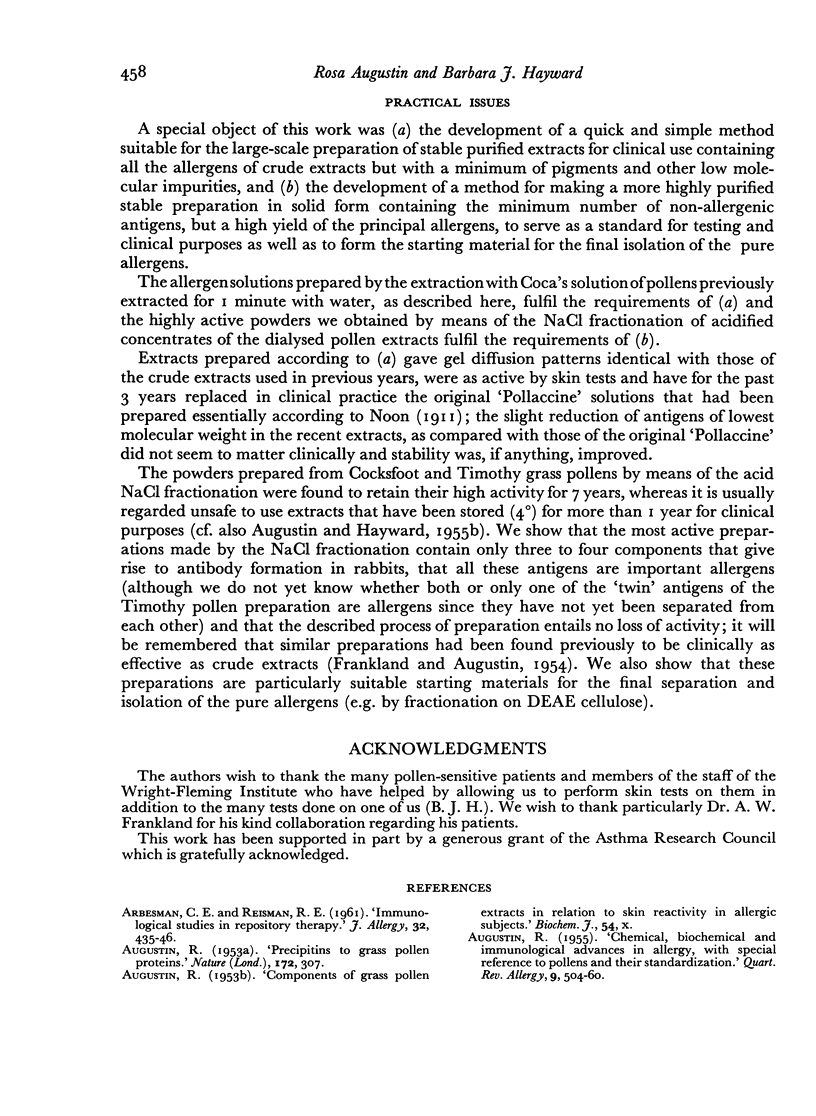

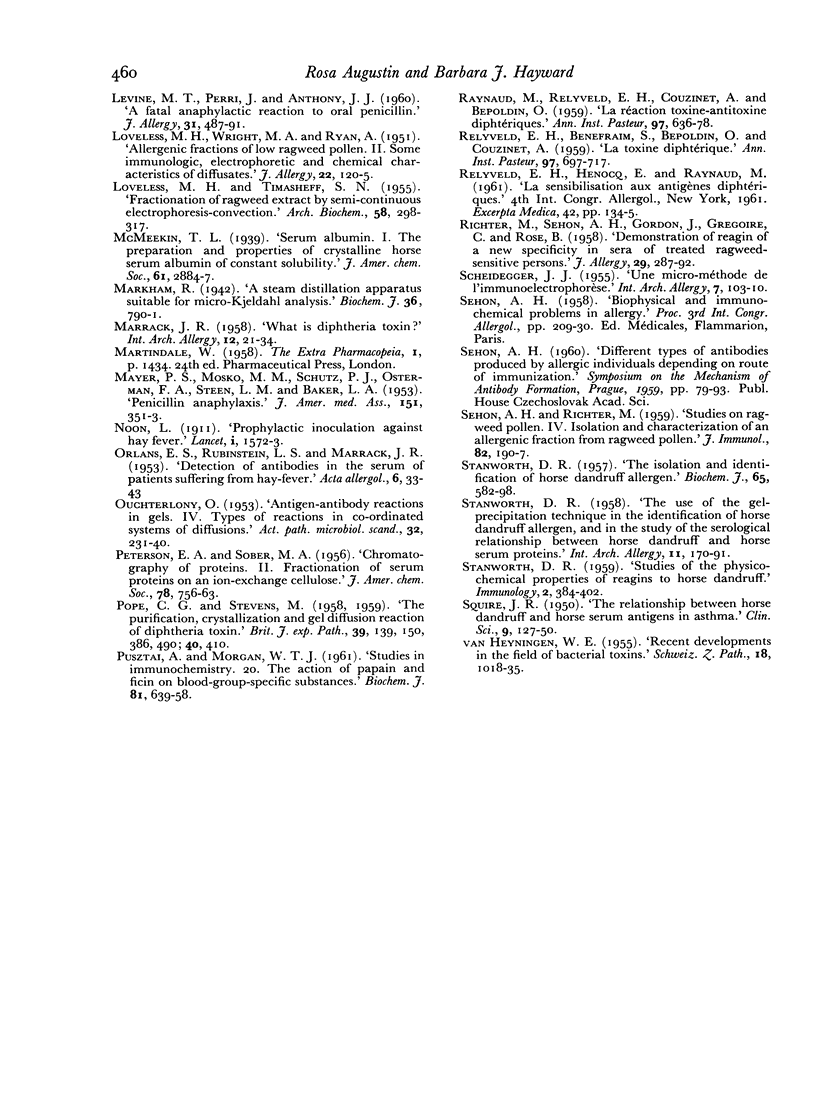
Images in this article
Selected References
These references are in PubMed. This may not be the complete list of references from this article.
- AUGUSTIN R. Chemical, biochemical and immunologic advances in allergy, with special reference to pollens and their standardization. Q Rev Allergy Appl Immunol. 1955 Dec;9(4):504–560. [PubMed] [Google Scholar]
- AUGUSTIN R. Grass pollen allergens. II. Antigen-antibody precipitation patterns in gel: their interpretation as a serological problem and in relation to skin reactivity. Immunology. 1959 Apr;2(2):148–169. [PMC free article] [PubMed] [Google Scholar]
- AUGUSTIN R. Grass pollen allergens. III. Their differentiation from the other pollen antigens by immuno-electrophoretic studies in relation to skin reactivity, enzymic digestions, heat and pH stabilities. Immunology. 1959 Jul;2:230–251. [PMC free article] [PubMed] [Google Scholar]
- AUGUSTIN R., HAYWARD B. J. Immunochemical studies of human serum proteins. Antigenic inhomogeneities of the gamma globulins, their subunits and number of determinants and their relation to a Waldenstrom macroglobulin. Immunology. 1961 Oct;4:450–472. [PMC free article] [PubMed] [Google Scholar]
- AUGUSTIN R., HAYWARD B. J., SPIERS J. A. Antigen-antibody reactions in agar. I. Experimental tests of current theories of Oudin's single diffusion method. Immunology. 1958 Jan;1(1):67–80. [PMC free article] [PubMed] [Google Scholar]
- BECKER R. J., SPARKS D. B., FEINBERG S. M., PATTERSON R., PRUZANSKY J. J., FEINBERG A. R. Delayed and immediate skin reactivity in man after the injection of antigen in emulsion. Cell transfer of the delayed sensitivity. J Allergy. 1961 May-Jun;32:229–235. doi: 10.1016/0021-8707(61)90052-1. [DOI] [PubMed] [Google Scholar]
- FRANKLAND A. W., AUGUSTIN R. Grass pollen antigens effective in treatment. Clin Sci. 1962 Aug;23:95–102. [PubMed] [Google Scholar]
- Friedmann R. Characterization of sugar components of protein. Biochem J. 1949;44(1):117–126. [PMC free article] [PubMed] [Google Scholar]
- GOLDFARB A. R., BHATTACHARYA A. K., KOERNER S. K. Preparation and immunologic properties of trifidin A, an antigen from giant ragweed pollen. J Immunol. 1958 Oct;81(4):302–308. [PubMed] [Google Scholar]
- GOLDFARB A. R., MOORE D. H., RAPAPORT H. G., SKLAROFSKY B., GETTNER H. H., ABRAMSON H. A. Preparation and properties of a purified ragweed extract. Proc Soc Exp Biol Med. 1954 Feb;85(2):255–258. doi: 10.3181/00379727-85-20847. [DOI] [PubMed] [Google Scholar]
- HAYWARD B. J., AUGUSTIN R. Quantitative gel diffusion methods for assay of antigens and antibodies. Int Arch Allergy Appl Immunol. 1957;11(3-4):192–205. doi: 10.1159/000228415. [DOI] [PubMed] [Google Scholar]
- KUHNS W. J. Disappearance of human diphtheria antitoxin from human passive transfer skin sites. Proc Soc Exp Biol Med. 1961 Oct;108:63–67. doi: 10.3181/00379727-108-26845. [DOI] [PubMed] [Google Scholar]
- KUHNS W. J., PAPPENHEIMER A. M., Jr Immunochemical studies of antitoxin produced in normal and allergic individuals hyperimmunized with diphtheria toxoid. II. A comparison between the immunological properties of precipitating and non-precipitating (skin-sensitizing) antitoxins. J Exp Med. 1952 Apr;95(4):375–392. doi: 10.1084/jem.95.4.375. [DOI] [PMC free article] [PubMed] [Google Scholar]
- LEVINE M. I., PERRI J., ANTHONY J. J. A fatal anaphylactic reaction to oral penicillin. J Allergy. 1960 Nov-Dec;31:487–491. doi: 10.1016/0021-8707(60)90082-4. [DOI] [PubMed] [Google Scholar]
- LOVELESS M. H., TIMASHEFF S. N. Fractionation of ragweed extract by semicontinuous electrophoresis-convection. Arch Biochem Biophys. 1955 Oct;58(2):298–317. doi: 10.1016/0003-9861(55)90131-4. [DOI] [PubMed] [Google Scholar]
- MARRACK J. R. What is diphtheria toxin. Int Arch Allergy Appl Immunol. 1958;12(1-2):21–34. doi: 10.1159/000228440. [DOI] [PubMed] [Google Scholar]
- Markham R. A steam distillation apparatus suitable for micro-Kjeldahl analysis. Biochem J. 1942 Dec;36(10-12):790–791. doi: 10.1042/bj0360790. [DOI] [PMC free article] [PubMed] [Google Scholar]
- ORLANS E. S., RUBINSTEIN L. J., MARRACK J. R. Detection of antibodies in the serum of patients suffering from hay fever. Acta Allergol. 1953;6(1):33–43. doi: 10.1111/j.1398-9995.1953.tb03467.x. [DOI] [PubMed] [Google Scholar]
- SCHEIDEGGER J. J. Une micro-méthode de l'immuno-electrophorèse. Int Arch Allergy Appl Immunol. 1955;7(2):103–110. [PubMed] [Google Scholar]
- STANWORTH D. R. The isolation and identification of horse-dandruff allergen. Biochem J. 1957 Mar;65(3):582–598. doi: 10.1042/bj0650582. [DOI] [PMC free article] [PubMed] [Google Scholar]



